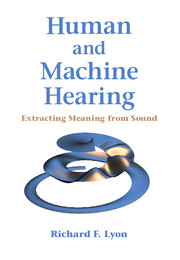Book contents
- Frontmatter
- Dedication
- Contents
- Foreword
- Preface
- Part I Sound Analysis and Representation Overview
- 1 Introduction
- 2 Theories of Hearing
- 3 On Logarithmic and Power-Law Hearing
- 4 Human Hearing Overview
- 5 Acoustic Approaches and Auditory Influence
- Part II Systems Theory for Hearing
- Part III The Auditory Periphery
- Part IV The Auditory Nervous System
- Part V Learning and Applications
- Bibliography
- Author Index
- Subject Index
- Plate section
1 - Introduction
from Part I - Sound Analysis and Representation Overview
Published online by Cambridge University Press: 28 April 2017
- Frontmatter
- Dedication
- Contents
- Foreword
- Preface
- Part I Sound Analysis and Representation Overview
- 1 Introduction
- 2 Theories of Hearing
- 3 On Logarithmic and Power-Law Hearing
- 4 Human Hearing Overview
- 5 Acoustic Approaches and Auditory Influence
- Part II Systems Theory for Hearing
- Part III The Auditory Periphery
- Part IV The Auditory Nervous System
- Part V Learning and Applications
- Bibliography
- Author Index
- Subject Index
- Plate section
Summary
… things inanimate have mov'd,
And, as with living Souls, have been inform'd,
By Magick Numbers and persuasive Sound.
—William Congreve (1697) The Mourning BrideThe ear is a most complex and beautiful organ. It is the most perfect
acoustic, or hearing instrument, with which we are acquainted,
and the ingenuity and skill of man would be in vain exercised to imitate it.
—John Frost (1838), The Class Book of Nature: Comprising Lessons on the Universe, the Three Kingdoms of Nature, and the Form and Structure of the Human BodyWould it truly be in vain to exercise our ingenuity to imitate the ear? It would have been, in the 1800s—but now we are beginning to do so, using the “magick” of numbers. Machines imitating the ear already perform useful services for us: answering our queries, telling us what music is playing, locating gunshots, and more. By imitating ears more faithfully, we will be able to make machines hear even better. The goal of this book is to teach readers how to do so.
Understanding how humans hear is the primary strategy in designing machines that hear. Like the study of vision, the study of human hearing is ancient, and has enjoyed impressive advances in the last few centuries. The idea of machines that can see and hear also dates back more than a century, though the computational power to build such machines has become available only in recent decades. It is now, as they say in the computer business, a simple matter of programming. Well, not quite—there is still work to be done to firm up our understanding of sound analysis in the ear, and yet more to be done to understand the enormous capabilities of the human brain, and to abstract these understandings to better support machine hearing. So let's get started.
Humans tend to take hearing for granted. We are so aware of what's going on around us, largely by extracting information from sound, yet so unable to describe or appreciate how we do it. Can we make machines do as well at interpreting their world, and ours, through sound? We can, if we leverage scientific knowledge of how humans process sound.
- Type
- Chapter
- Information
- Human and Machine HearingExtracting Meaning from Sound, pp. 5 - 22Publisher: Cambridge University PressPrint publication year: 2017



